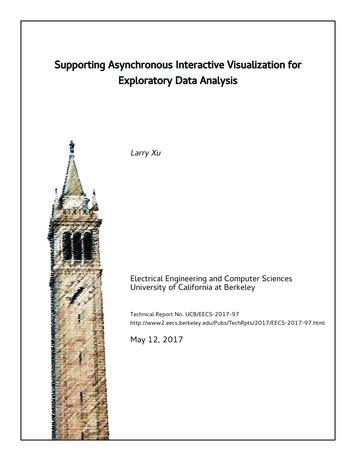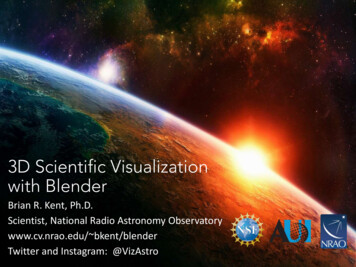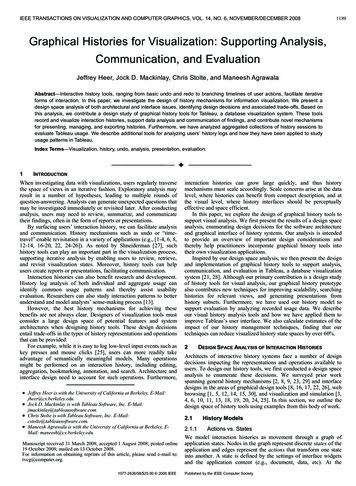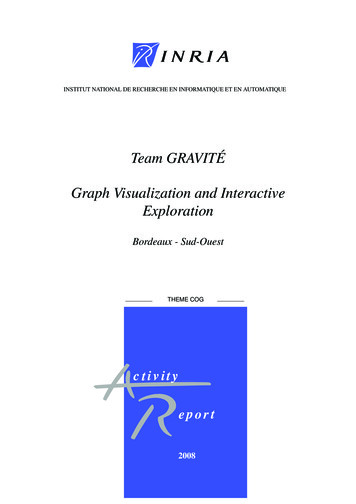
Transcription
Supporting Asynchronous Interactive Visualization forExploratory Data AnalysisLarry XuElectrical Engineering and Computer SciencesUniversity of California at BerkeleyTechnical Report No. /TechRpts/2017/EECS-2017-97.htmlMay 12, 2017
Copyright 2017, by the author(s).All rights reserved.Permission to make digital or hard copies of all or part of this work forpersonal or classroom use is granted without fee provided that copies arenot made or distributed for profit or commercial advantage and that copiesbear this notice and the full citation on the first page. To copy otherwise, torepublish, to post on servers or to redistribute to lists, requires priorspecific permission.
Supporting Asynchronous Interactive Visualizationfor Exploratory Data Analysisby Larry XuResearch ProjectSubmitted to the Department of Electrical Engineering and Computer Sciences,University of California at Berkeley, in partial satisfaction of the requirements for thedegree of Master of Science, Plan II.Approval for the Report and Comprehensive Examination:Committee:Professor Joseph M. HellersteinResearch Advisor(Date)*******Professor Eugene WuSecond Reader5/9/17(Date)
AbstractSupporting Asynchronous Interactive Visualization for Exploratory Data AnalysisbyLarry XuMaster of Science in Electrical Engineering and Computer SciencesUniversity of California, BerkeleyProfessor Joseph M. Hellerstein, ChairInteractive data visualizations have become a powerful tool for exploratory data analysis, allowing users to quickly explore different subsets of their data and visually testhypotheses. While new design tools have made creating such visualizations easier, thesetools often do not scale well to large datasets that do not fit on a user’s machine. Thisbecomes increasingly more common as data collection grows and storage costs becomecheaper. In such cases, the visualization must request new data across a network foreach interaction. When interactive latencies are introduced to a visualization, the userexperience can deteriorate to the point of being inconsistent and unusable. To addressthese issues we present a new interaction design technique, Chronicled Interactions, whichallows for creating asynchronous interactive visualizations that are resilient to latency.Through online user studies, we validate that users are able to complete visual analysistasks quicker with this new design compared to a traditional interface under conditionsof latency.
iContentsContentsi1 Introduction12 Modeling Interactive Visualizations2.1 Event streams . . . . . . . . . . . . . . .2.2 Human-in-the-loop distributed systems2.3 Visual encodings . . . . . . . . . . . . .2.4 Cognition . . . . . . . . . . . . . . . . . .556893 Chronicled Interactions3.1 Data layer: history of interactions . . . . . . . . . .3.2 Visual layer: visualizing history . . . . . . . . . . .3.3 Correspondence: mapping interactions to results .3.4 Summary . . . . . . . . . . . . . . . . . . . . . . . .1213161819.4 User Experiments214.1 Spatial vs. temporal designs . . . . . . . . . . . . . . . . . . . . . . . . . . . . 214.2 Experiment design . . . . . . . . . . . . . . . . . . . . . . . . . . . . . . . . . 224.3 Experiment analysis . . . . . . . . . . . . . . . . . . . . . . . . . . . . . . . . . 265 Conclusion35Bibliography36
iiAcknowledgmentsThis work would not have been possible without the help of so many individuals Ihave had the honor of collaborating with. I would like to thank my research advisorJoseph Hellerstein for providing enormous support throughout both my undergraduate and graduate years at Berkeley. He has been a great source of advice in research,teaching, and graduate school, and I am constantly impressed by his wide breadth ofexpertise and ability to balance academic, professional, and personal life. Eugene Wu,who I like to consider my second advisor at Columbia University, thank you for takinga chance on a young Berkeley undergrad during your short time here at Berkeley twoyears ago, and for guiding and mentoring me through research and academia ever sincethen. Remco Chang at Tufts University, thank you for contributing your wealth of HCIwisdom, and always keeping things down-to-earth in all of our discussions. And to myresearch partner in crime, Yifan Wu, none of this work would have been possible without you and I am grateful for having been able to work together in the research trenchesthis past year.Many others have helped me throughout my academic research journey at Berkeleythat I would like to thank as well. Thank you to Arnab Nandi of Ohio State Universityand his group there including Meraj Ahmed Khan and Lilong Jiang for the opportunityto work on research together during my time as an undergrad. Thank you to EugeneWu’s group at Columbia University including Hamed Nilforoshan and James Sandsfor contributing their time and energy on supporting our experiments. Thank you tomembers of the Berkeley AMPLab & RISELab community including Daniel Haas andSanjay Krishnan for their sage advice both in previous research and in the work presented here. And to my fellow lab students Michael Whittaker, Johann Schleier-Smith,Vikram Sreekanti, and Chenggang Wu, thank you for inspiring me through your workand teaching me a little something new every week.Thank you to all my friends who have helped keep me sane during my last year atBerkeley, and for all the memories, laughs, and misadventures we shared. And finally,thank you to my parents, Nelson and Connie, and my brother Kevin for supporting mein all that I have failed and accomplished until now, and for their continual support inthe future.
1Chapter 1IntroductionVisualization plays a large role in exploratory data analysis as a method of gainingvaluable insights from looking at data. Visual analysis leverages human perception tofind patterns that may not be immediately evident from looking at a table of numbers.A classical example of this is shown in Figure 1.1, Anscombe’s quartet [2]—four datasetswith the exact same descriptive statistics (mean, variance, correlation), but that revealwildly different patterns when plotted. This simple example highlights the ability ofvisualizations to easily reveal trends and anomalies in data. Heer et al. [19] present acomprehensive list of visualization techniques for exploratory 5xFigure 1.1: Anscombe’s quartet10x1520
CHAPTER 1. INTRODUCTION2The creation of domain-specific tools and languages has made designing such datavisualizations progressively easier. ggplot2 [43] in R allows for declaratively specifyinggraphs without any imperative logic involved. With only a few simple commands, usersare able to visualize data and customize a visualization through specifying differentencodings. D3 [5] has become widely used for its ability to easily author visualizationson the web. It supports a diverse set of charts through visual primitives and plugins.The success of ggplot2 and D3 has shown that lowering the complexity for creatingvisualizations enables people to perform quicker analysis and communicate their resultsfaster.More recently, interactive data visualizations have enabled richer user experiencesfor exploring data. Visualizations that support interactions allow the user to directlymanipulate the data and process multiple views or subsets. While static visualizationsare useful for analyzing small datasets with simple quantitative or categorical variables,accommodating large datasets with different kinds of variables such as geospatial, timeseries, or relational data can be challenging. To support a wide variety of variable types,it is useful to display data in an integrated visual dashboard with multiple differentcoordinated views.Figure 1.2: MapD NYC Taxi Rides interactive data visualization. This visual dashboardlets users explore multiple dimensions of taxi data and uses a variety of visual displaysincluding map, time series, and histograms. These displays are coordinated, such thatinteractions which filter one display affect the other displays.
CHAPTER 1. INTRODUCTION3Consider the MapD visual dashboard of NYC taxi rides in Figure 1.2 [26]. This highdensity display allows exploration of one billion records of data. Such information density cannot be captured with tabular data displays or static visualization displays. Forthe dashboard to be effective, it relies heavily on interaction to allow users to explore different parts of the data and gain relevant insights. The dashboard itself does not leverageparticularly complex visualizations. Maps, line charts, and histograms are common representations used in data analytics. Interactive visual dashboards can contain a diverseassortment of charts and visualizations, and any interactive filtering applied to one viewwill affect the others in a technique called brushing and linking [3].Developing interactive visualizations like this can be much more difficult and timeconsuming compared to their static counterparts. Designers must reason about imperative event handling and state management to support interactions. Common visualization toolkits such as ggplot2 and D3 do not natively support interactions, so new toolshave been developed specifically for interactive visualizations. Vega [35] is an interactive visualization grammar which attempts to address these issues through declarativeabstractions. It is able to support high-level descriptions of interaction behaviors without needing to specify imperative event handling procedures. Although less declarativethan Vega, Plotly [36] similarly provides a library for easily creating interactive visualizations without the need for complex code. Both of these tools are targeted at authoringinteractive web visualizations.Despite this progress in easily specifying interactive visualizations, there exists another issue that needs to be addressed when creating high-density interactive visualizations as in the MapD example. The visualization must be able to scale to large datasets tosupport interactive big data analytics. This typically requires querying data across a network. Data may be distributed across multiple machines and geographically decentralized. When trying to explore and analyze such a large distribution of data, queries mustbe made to multiple different nodes involving potentially large data transfers across anetwork. For example, consider a sales analyst looking at data managed by an ApacheSpark [45] cluster to aggregate their company sales data from across multiple geographicregions. Each query they run can take on the order of seconds to complete [8], makingit prohibitively expensive to interactively explore multiple slices of data in sequence.One of the prominent challenges of visual analysis today is enabling interactive datavisualization for large-scale exploratory data analysis scenarios such as these. The coreissue is limiting latency and its effects on the usability of a visualization. Given that thedata analyzed in a visualization may not be immediately available on a user’s machine,they must make network requests to one or more remote sources for data. These requestsinherently incur latency that scales with the size of the data or workload being queried.When every user interaction performs a new request, this can slow down productivityand the ability to effectively explore the data. Variance in latencies can cause out-of-orderresponses, and potentially result in inconsistencies on the interface. These can create afrustrating user experience by exacerbating cognitive issues in visualizations such aschange blindness [31], short term memory limits [6], and the gulf of evaluation [30].
CHAPTER 1. INTRODUCTION4In response to these challenges, special-purpose systems such as MapD’s GPU accelerated database and visual interface have been built to handle low-latency visualanalytics queries on large datasets. Tableau [42] offers its own system for composing visualizations from heterogeneous data sources such as multiple different databases. Suchtools can be compelling for interactive big data analytics, where visual toolkits like D3cannot scale. Although proprietary end-to-end visualization systems like Tableau andMapD are making the problems of latency in interactive visualizations easier, they require buying into an ecosystem rather than allowing visualization designers freedom towork with their own tools. Similarly, while a large variety of known backend techniquesexist for decreasing latency such as sampling, aggregation, and caching; these are notgeneral-purpose enough to work with all data sources and are still limited by variancein network speeds.So the motivating question becomes, can we create simple interaction designs that arestill effective in the face of latency? By starting with the assumption that latency existsin an interactive visualization, we can better design around this issue. In this thesis wepresent Chronicled Interactions, a model for designing asynchronous interactive visualizations that are resilient to issues of interactive latency. The model is meant to extendexisting visualization toolkits to better support large datasets for exploratory analysisacross a variety of backend data systems. Through a set of online user studies, wedemonstrate that users can effectively leverage these new interaction designs to improveperformance on a variety of visual analysis tasks under latency compared to traditionalinterfaces.
5Chapter 2Modeling Interactive VisualizationsTo design effective interactive visualizations for large-scale exploratory data analysisscenarios, we first survey existing methods of modeling interactions and their corresponding visual results. These will help inform the design decisions of our ChronicledInteractions model in the next chapter. We broadly look at literature from the systems,human-computer interaction, and cognitive science communities for ways to design andreason about interactive visualizations.2.1 Event streamsOne approach to working with interactions is to model them as event streams. Each typeof user input represents a separate stream, so for example there can be a mousemovestream, a click stream, and a keypress stream; and different interface elements can havetheir own separate event streams. Thus, the actual mechanism for producing the interaction can be abstracted away as purely an event source in a dataflow architecture. SeeFigure 2.1 for an example event stream diagram.This approach is adopted by Reactive Extensions [28] and Cycle.js [11] to build reactive user interfaces that can automatically propagate user input events to the appropriate application functions which re-render the UI. These frameworks are built off offunctional reactive programming principles as a way to control asynchronous event handling. The Vega runtime [35] also incorporates this idea and allows for declarativelyperforming operations on streams of input events. Vega is able to create interactive visualizations through a declarative specification without the need for imperative eventhandling logic.The reactive dataflow programming paradigm has been previously explored in otherlanguages such as Haskell [29]. It offers a powerful method for composing programsas a directed operation graph. Data flows through the graph and can be transformed ateach operation. The user interface rendering can also be modeled as an operator in sucha graph. It processes a stream of render events which are mapped to visual updates
CHAPTER 2. MODELING INTERACTIVE VISUALIZATIONS6mousemove(x, y)(22, 20)(46, 53)(74, 68)Figure 2.1: Mousemove event stream. Upon each movement of the user’s mouse cursor,the stream propagates an event with the ( x, y) coordinates of the cursor position. Thisstream can be fed into a reactive dataflow architecture or mapped to other streams forfurther processing of the events.on screen. The developer defines the operators, and the execution environment streamsdata through them at runtime.Van Wijk explored a similar model of interactive visualization as an operation graph[41]. A key difference is that in his model, interactions only modify the visual specification of how data gets mapped into visual marks. We consider this a subset of interactions, and also consider cases where interactions can modify the actual data beingvisualized. This is the case when an interaction issues a new query for data. For example, when a user pans a map and new data points are drawn according to the newregion of interest. In all future discussion of interactions, we consider interactions thataffect both the visual specifications and underlying data.2.2 Human-in-the-loop distributed systemsTypical distributed system models only consider the actual machines communicatingover the network, while abstracting away the human user as part of the client machine.However, we can adopt a human-in-the-loop view which considers the user as a node inthe system much like any other machine node as in Figure 2.2. The user sends requeststo the client machine in the form of interactions and receives responses through visualupdates to their screen. And so we can model the user in the context of the wholedistributed system, with consideration of how communication is handled between theuser and rest of the system. This approach is helpful for considering the needs of theuser and applying systems ideas to explain user behaviors. For example, consider thefollowing sequence of events that occur during a single user interaction:
CHAPTER 2. MODELING INTERACTIVE VISUALIZATIONS1 click point A2a,3 showUser2b request data for A4 send response dataindicator5 render new chart7ClientServerFigure 2.2: Human-in-the-loop view of an interactive visualization system1. User Joe hovers over a data point A through a mouse interaction, represented hereas a “request” from Joe to the client interface.2. The client receives Joe’s request via a mousemove event handler and processes itbya) immediately responding back to Joe’s request, represented here as an updateto the visual marks on the screen (e.g. showing a loading indicator)b) sending a new request to a backend server for more data, parameterized bythe id of the data point A which Joe selected3. Joe receives the immediate visual feedback that his request is being processed4. The backend server receives the request for data on point A, processes it (potentially requiring even more requests to other remote machines), and then sends backa response5. The client receives the server’s response, processes it, and then sends another message to Joe by updating the visual marks on the screen (e.g. rendering a newvisualization)6. Joe receives the new information, processes it, and performs a new interaction(back to step 1)This short example sequence demonstrates the inherent difficulty and complexity ofdesigning an interactive user interface that supports large-scale data exploration. Multiple points of communication between the user, client, and server means that a robust visualization should mitigate failures and handle them appropriately if they occur.Speaking only from the client machine’s perspective, it must carefully keep track of internal state and know how to respond to messages both from the user and the server.Handling this logic and carefully managing the state can become a challenge for thedeveloper working on the visualization software. If not handled properly, subtle bugsare likely to be introduced in complex applications.For each interaction the user performs, there are actually two responses that theyreceive. One is the immediate visual feedback that acknowledges their request, and the
CHAPTER 2. MODELING INTERACTIVE VISUALIZATIONS8other is the intended visual effect upon receiving data from the server. By decouplingthese two, we make an important distinction that many interfaces fail to address. Interfaces that lack proper visual feedback mechanisms such as loading spinners or progressbars can leave the user confused about the state of UI. Such confusion can often lead tothe user performing multiple repeated interactions such as repeatedly clicking a buttonwhen unsure if previous clicks were being registered and processed. If left in a state ofconfusion for too long or if the interface actually does become broken from a subtle bug,the user may become frustrated and restart their entire interactive session.An interaction can also initiate more than one request. For example if the user pansacross a map, the client machine could send one request for additional data to loadthe underlying geographic map, as well as another request for data points within thespecified area of the map which are rendered as a layer on top of the map. If the requestfor the data points finishes before the request for the mapping data, then the developermust decide whether it makes sense to render the data points without the context of themap or to delay the rendering until the mapping data is also received.Furthermore, consider the fact that within a single interactive session, a user canissue multiple interactions concurrently while other results are still processing. In themapping example, the user could pan across the map multiple times in quick successionbefore any data points load. In which case the client should ignore the previous requestsfor data, and render the response data for only the region of the map which is actuallybeing viewed.Though not a focus of this work, the model described here can be extended to supportreal-time streaming updates represented as data being sent from the server irrespectiveof any requests from the user or client. Therein lies another set of challenges of effectivelycommunicating updates to the user with real-time constraints.2.3 Visual encodingsSo far in this chapter we have examined models of the user interaction process withexamples that are grounded in interactive visualization interfaces. However, these interaction models are applicable to any interactive user interface in general. So to bettermotivate the design of a new model for interactive data visualizations, we now spendthe rest of the chapter discussing models focused specifically around data visualization.Data visualization can be described as the process of encoding data into visual marks.A visual mark is the basic unit of a visualization, such as a point, line, or area. Variables of the data are encoded as visual properties of the marks called visual variables.Examples of commonly used visual variables are position, size, and color. These visualmarks can then be decoded by a human’s perceptual system to read the data. Figure 2.3presents a diagram of this model. The process of perceptual decoding is imperfect,and is highly affected by both the visual encodings used and the user’s own percep-
CHAPTER 2. MODELING INTERACTIVE VISUALIZATIONS9tual idiosyncrasies. We discuss the cognitive aspects of reading and interacting with avisualization in the next section, but for now focus on the aspects of visual mapping.{ age: .,weight: ., gFigure 2.3: The visual encoding and decoding processIn his book, Semiology of Graphics, Jacques Bertin describes cartographic visualizations as the composition of marks, which serve as the basic unit of visualization, aswell as visual variables which can vary the properties of those marks (e.g. size, color,shape) [4]. His initial list of seven visual variables was later expanded upon by Mackinlay et al. [25], who provided a ranking of their effectiveness for various perceptual tasksin order to guide visual design recommendations. More recently, variables such as time,motion, 3D, and transparency were introduced, made possible through the use of computers and animated graphics for visualization. Beyond Mackinlay et al.’s work, therehas been a large body of research over the years which seeks to understand which visual variables are more effective for perceptual accuracy in a variety of tasks [9, 20, 37].Understanding the effects of different visual encodings is important for designing visualizations that are usable and effective at conveying information. This is especially truein settings when visualizing multi-dimensional data where a separate visual encodingmust be used for each dimension of the data.2.4 CognitionThe process of viewing and interacting with a data visualization can be further examinedthrough a cognitive lens to better understand usability constraints and human difficultieswhen using a visualization. This is critical for designing human-in-the-loop data analysissystems so that failure cases and human error can be mitigated. There is a variety ofcognitive science literature focused on the areas of perception and memory which canbe relevant to interactive visualizations. By modeling user behavior when interactingwith a visualization, we can design better interfaces that leverage the user’s cognitiveabilities.As described in the previous section, the process of visually decoding a visualizationinherently relies on the user’s perceptual system to read an accurate value from the
CHAPTER 2. MODELING INTERACTIVE VISUALIZATIONS10marks on their screen. This can be a difficult or easy task depending on the type ofvisual encoding used. Cleveland et al. studied perceptual accuracy rankings for readingdifferent types of charts such as aligned bar charts, stacked bar charts, and pie charts [9].Their findings showed significant differences in users’ abilities to read certain chartsand accurately describe their encoded values. This motivates careful consideration fordesigning visualizations, which should ideally leverage encodings with high perceptualaccuracy.Change blindness is the perceptual phenomenon of humans being unable to perceivea visual change, even if the change is not very subtle. Applied to an interactive visualization setting, this can happen when there are many updates that are happening tooquickly or to different parts of the screen. It can be difficult for a user to focus theirattention on multiple coordinated views and be consciously aware of every change thatoccurs on screen. Finding methods to counteract change blindness is an active area ofresearch that can be applied to visualization designs [31]. For example, one such methodis to leverage pre-attentive visual attributes. These are attributes which human eyes areable to notice typically within less than 200-250 ms [17]. The use of pre-attentive visualattributes such as hue, size, and orientation, removes the need for humans to performfocused visual attention processing on areas of the screen, lessening the time required toabsorb information and increasing the likelihood of noticing changes of a visual interface.In an interactive environment with latency, it might be difficult for humans to understand how their interactions affected the results on screen if it takes multiple seconds forinteractions to be processed. Referred to as the “gulf of evaluation”, the user has difficulty determining the state of the system when no visual feedback is given in response totheir interactions [30]. Hutchins et al. advocated the use of direct manipulation to lessenthis gulf by directly fulfilling user’s expectations of how their actions are interpretedby the interface [22]. While direct manipulation may seem impractical in an interactivesetting with latency, there are other methods which can be used to help reduce the gulfof evaluation. For example, visual feedback mechanisms such as progress indicators canbe displayed when interactions are being processed so that the user knows their actionshave been acknowledged by the system.While most cognitive information visualization research has focused on the topic ofhuman visual perception, the emergence of highly interactive visualizations makes it relevant to look at a broader scope of HCI research. Card et al. defined the Model HumanProcessor in 1983 as a method for modeling the time spent by a user performing a cognitive task, broken down by perception, memory, and motor functions [6]. This modelis useful for estimating how a user might interact with a visualization. For example,their experiments suggest that an average human working memory can hold about 7chunks of information with a half-life decay of about 7 seconds. When interacting witha visualization, a user typically employs their short term memory. In an exploratorydata analysis setting, the visualization that a user interacts with can change quickly overthe course of an interaction sequence and so it is likely for the human memory to fill up.
CHAPTER 2. MODELING INTERACTIVE VISUALIZATIONS11Unlike computer memory, human memory is limited and so visualization tools can account for this by reducing human memory load when possible, for example by keepingimportant data visible on screen.Hollan et al. introduced the Distributed Cognition framework in 2000 for reasoningabout the cognitive effects of embodied agents interacting within an environment [21].Their work explores multiple ideas of how to design tools in the context of a networkedand distributed environment. Relevant to the study of interactive visualizations is theirnotion of history-enriched digital objects and effective use of spatial layouts. They arguethat applications which encode the history of past use can facilitate interaction similar toaffordances in the physical world such as physical wear of a tool. The more recent workon HindSight [13], a system for encouraging exploration by visualizing past interactionhistory, embodies this notion. The Distributed Cognition framework also argues thateffective use of space can reduce the time and memory demands of certain tasks, as spacecan be used to encode order
interactive web visualizations. Despite this progress in easily specifying interactive visualizations, there exists an-other issue that needs to be addressed when creating high-density interactive visualiza-tions as in the MapD example. The visualization must be able to scale to large datasets to support interactive big data analytics.










